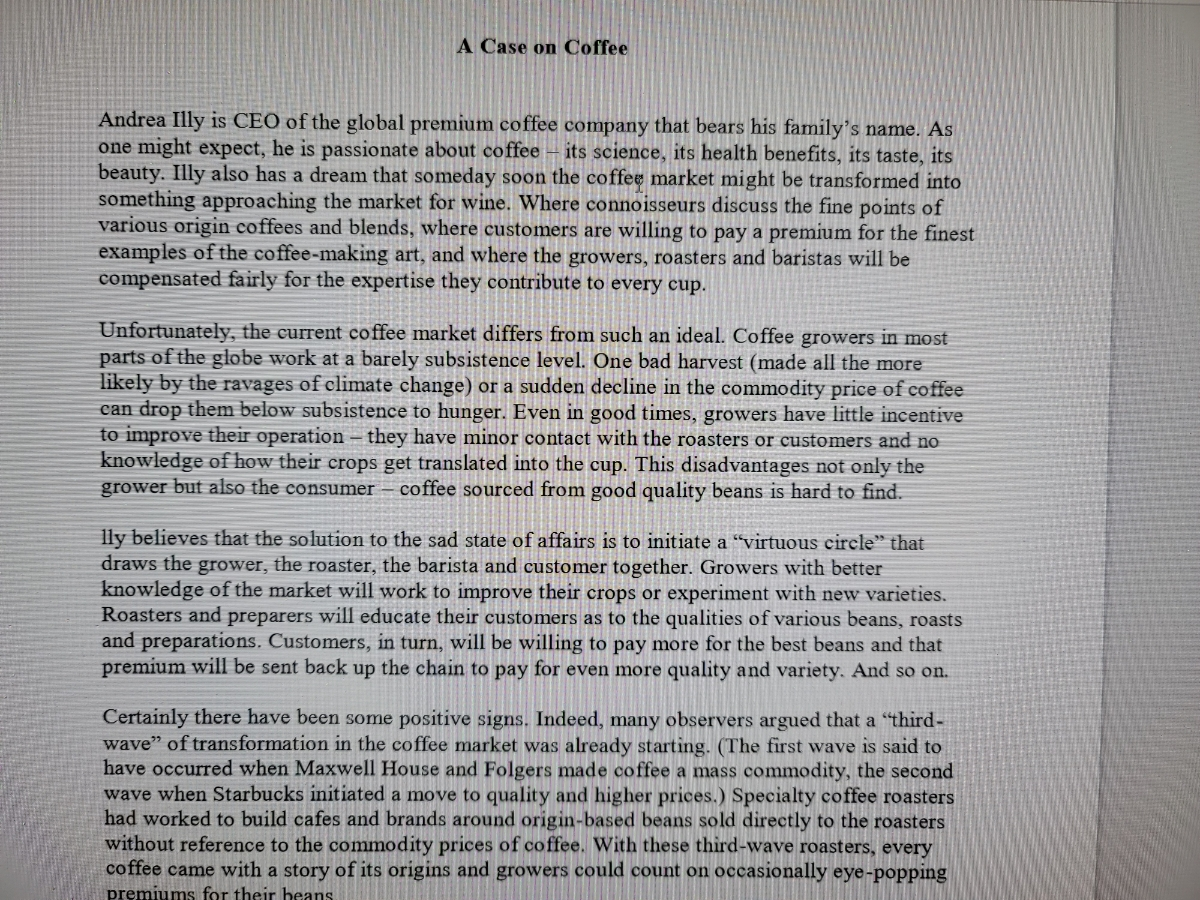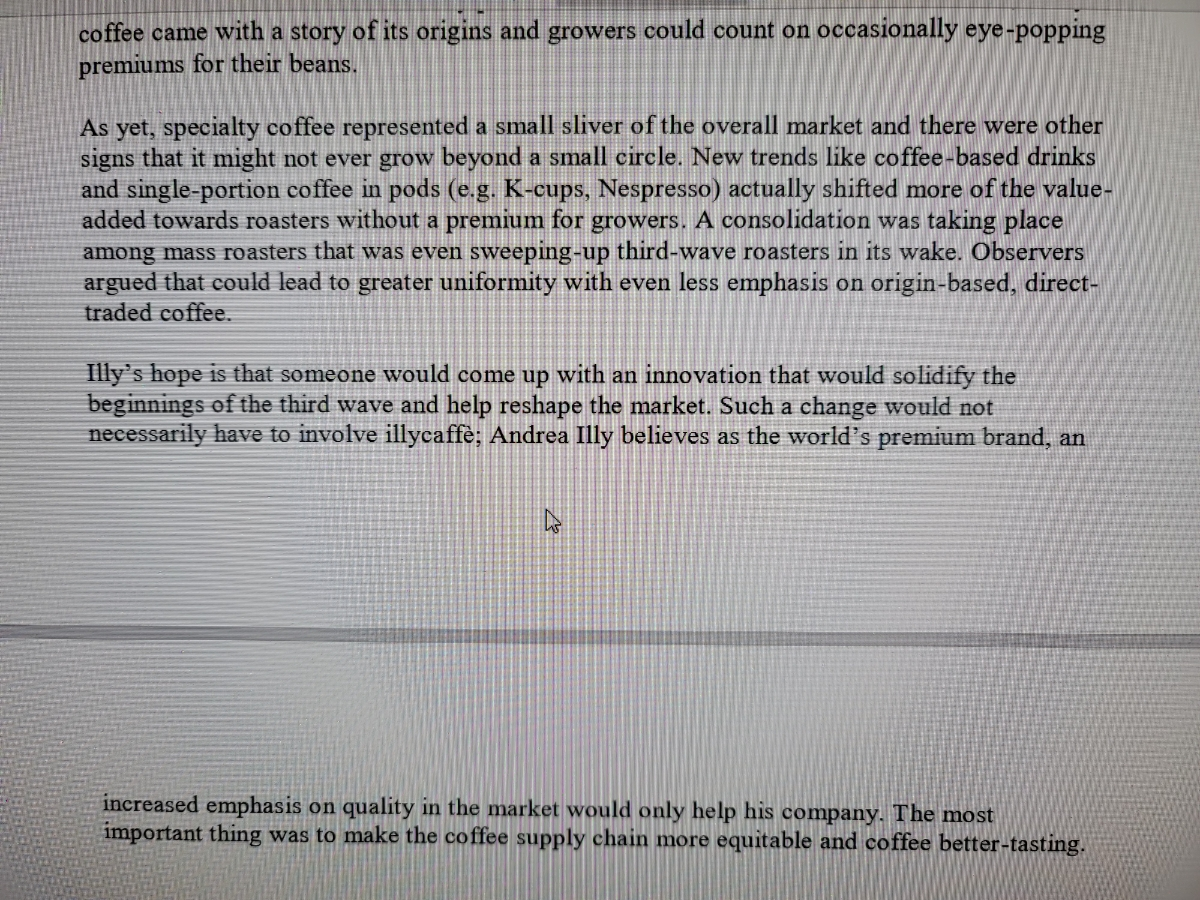Chapter17: Organizational Planning And Controlling
Section: Chapter Questions
Problem 3CTQ: The case focuses on U.S. markets. How are European markets affected by holiday shopping?
Related questions
Question
What is an innovative way to launch a third wave initiative to reach more of the market?

Transcribed Image Text:A Case on Coffee
Andrea Illy is CEO of the global premium coffee company that bears his family's name. As
one might expect, he is passionate about coffee – its science, its health benefits, its taste, its
beauty. Illy also has a dream that someday soon the coffee market might be transformed into
something approaching the market for wine. Where connoisseurs discuss the fine points of
various origin coffees and blends, where customers are willing to pay a premium for the finest
examples of the coffee-making art, and where the growers, roasters and baristas will be
compensated fairly for the expertise they contribute to every cup.
Unfortunately, the current coffee market differs from such an ideal. Coffee growers in most
parts of the globe work at a barely subsistence level. One bad harvest (made all the more
likely by the ravages of climate change) or a sudden decline in the commodity price of coffee
can drop them below subsistence to hunger. Even in good times, growers have little incentive
to improve their operation – they have minor contact with the roasters or customers and no
knowledge of how their crops get
grower but also the consumer – coffee sourced from good quality beans is hard to find.
slated into the cup. This disadvantages not only the
lly believes that the solution to the sad state of affairs is to initiate a "virtuous eirele" that
draws the grower, the roaster, the barista and customer together. Growers with better
knowledge of the market will work to improve their crops or experiment with new varieties.
Roasters and preparers will educate their customers as to the qualities of various beans, roasts
and preparations. Customers, in turn, will be willing to pay more for the best beans and that
premium will be sent back up the chain to pay for even more quality and variety. And so on.
Certainly there have been some positive signs. Indeed, many observers argued that a "third-
wave" of transformation in the coffee market was already starting. (The first wave is said to
have occurred when Maxwell House and Folgers made coffee a mass commodity, the second
wave when Starbucks initiated a move to quality and higher prices.) Specialty coffee roasters
had worked to build cafes and brands around origin-based beans sold directly to the roasters
without reference to the commodity prices of coffee. With these third-wave roasters, every
coffee came with a story of its origins and growers could count on occasionally eye-popping
premiums for their heans

Transcribed Image Text:coffee came with a story of its origins and growers could count on occasionally eye-popping
premiums for their beans.
As yet, specialty coffee represented a small sliver of the overall market and there were other
signs that it might not ever grow beyond a small circle. New trends like coffee-based drinks
and single-portion coffee in pods (e.g. K-cups, Nespresso) actually shifted more of the value-
added towards roasters without a premium for growers. A consolidation was taking place
among mass roasters that was even sweeping-up third-wave roasters in its wake. Observers
argued that could lead to greater uniformity with even less emphasis on origin-based, direct-
traded coffee.
Illy's hope is that someone would come up with an innovation that would solidify the
beginnings of the third wave and help reshape the market. Such a change would not
necessarily have to involve illycaffè; Andrea Illy believes as the world's premium brand, an
increased emphasis on quality in the market would only help his company. The most
important thing was to make the coffee supply chain more equitable and coffee better-tasting.
Expert Solution
This question has been solved!
Explore an expertly crafted, step-by-step solution for a thorough understanding of key concepts.
This is a popular solution!
Trending now
This is a popular solution!
Step by step
Solved in 2 steps

Recommended textbooks for you

